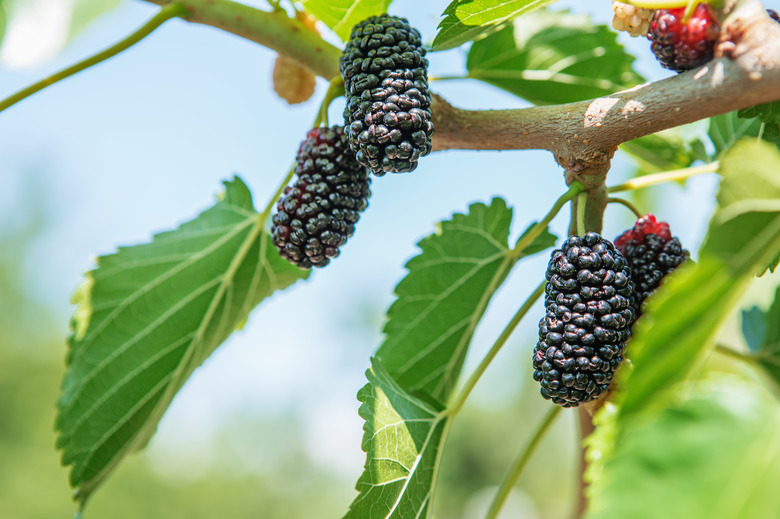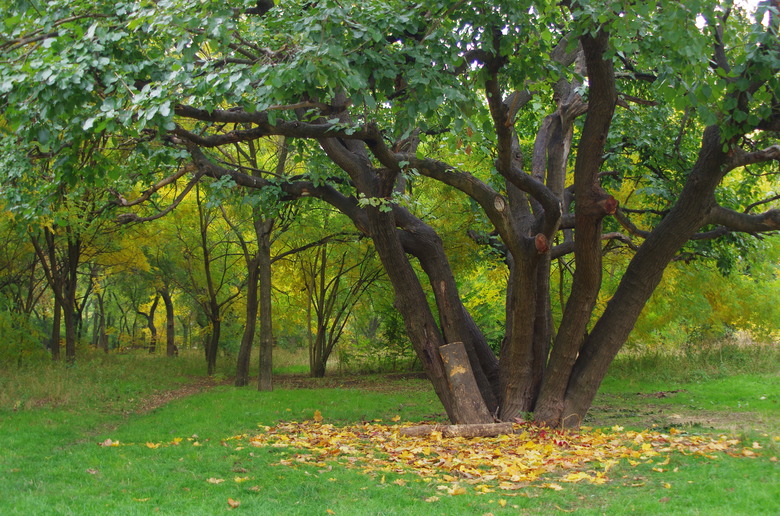How To Grow A Mulberry Tree (Morus Rubra)
Do you want to incorporate more native plants in your landscape? If so, plant a red mulberry tree (Morus rubra, USDA zones 4-9) in your backyard and celebrate your conservation efforts. Also called common mulberry, these beautiful fruit trees have made it onto the endangered species list in Connecticut and Massachusetts. In Michigan and Vermont, the tree is considered threatened.
Reaching mature heights of up to 60 feet, mulberry trees live long lives, many easily living to be 100. They produce juicy, edible berries in the spring or summer. Some mulberry trees grow both male and female flowers on the same plant, allowing them to pollinate themselves. Most, however, require you to plant both a male and female plant if you want to harvest fruit.
Although red mulberry trees grace your garden with a distinct look and produce a sweet, delicious berry, take note that the pollen of the male plant is notoriously adept at triggering pollen allergies. If you have a pollen allergy that flares each spring, mulberry trees may not be your best option. Here's what to know about growing and caring for a mulberry tree.
Best Uses for Red Mulberry Trees
The oval to heart-shaped leaves of the red mulberry tree give it a unique look and feel in the landscape. The trees look particularly nice clustered together in an area where you want to create a natural wooded look. They grow quickly and will provide a nice grove in about five years.
Although these North American natives do look lovely in the landscape, their juicy black and purple berries can be equal parts blessing and curse. Most gardeners grow these trees for the mulberry fruit they produce, which you can eat fresh or use to make jams, jellies, pies, and other goodies.
Mulberries are extremely juicy and delicate, however, which is why you won't find them at the grocery store. Although delicious, mulberries are simply too delicate to ship. The only way to enjoy them is to grow your own. Their delicacy makes berries easy to squash, though, which releases the juice inside them. This juice will stain anything and everything, including driveways and sidewalks, which can prove problematic.
To minimize the risk of staining your sidewalk and driveway, plant mulberry trees well away from these landscape features. It's also wise to plant these trees in an area that sees very little foot traffic. Berries can and have stained carpets and floors when stuck to the bottom of a shoe. If you like the look of a mulberry tree but not the mess, fruitless ornamental cultivars are available.
Starting a Red Mulberry Tree From a Sapling
The easiest and quickest way to get tasty mulberries is to simply purchase a young nursery tree and plant it in your yard. After all danger of frost has passed in the spring, choose a sunny spot for your mulberry tree and dig a planting hole twice the diameter of the tree's root ball and only deep enough to accommodate the roots. Gently wiggle the plant out of its nursery container and use your fingers to spread the roots apart a bit. Place the tree in the hole so that it sits at the same depth it enjoyed in the original container.
Backfill the planting hole with the excavated native soil. Tamp down the soil well and water your new tree thoroughly. If you're planting multiple trees, make sure you space them 30 to 50 feet apart.
In What Zone Do Red Mulberry Trees Grow Best?
The red mulberry tree is a perennial in USDA plant hardiness zones 4 through 9. In these areas, the deciduous trees will drop their leaves and go dormant over the winter, easily surviving until spring.
When Should You Plant Red Mulberry Trees?
Like many other species, red mulberry trees prefer spring planting, It's imperative that you wait until all danger of frost has passed before you plant your young tree. Planting in late spring prevents damage from a late frost and gives the new tree time to establish itself well before the next winter.
Soil, Sunlight, and Water Recommendations for Red Mulberry Trees
Although they prefer full sun, red mulberry trees will tolerate light shade. Just as they can adapt to part shade, so too can mulberries adapt to a variety of soils. They grow best in rich, well-drained soil with a pH between 5.5 and 7.0, but they'll tolerate just about anything except flooding and complete soil saturation. Irrigate as needed to keep the soil evenly moist. Dry trees tend to drop their fruit before it's ripe.
Once established, fertilize your tree with a 10-10-10 fertilizer or organic equivalent each spring, or according to soil-test recommendations. In fall, mulch around your tree with compost. Any rain you get during the winter will wash the nutrients into the soil and provide for your tree over the winter while it's resting.
Red mulberry trees generally do well without pruning, but the right training when they're young can promote greater fruit production. If you do opt to prune your tree, do so in late winter while the tree is still dormant and avoid making any cuts wider than 2 inches across. Red mulberry trees are often unable to heal large cuts, leaving them susceptible to insects and diseases.
When pruning, remove dead or diseased branches. You also want to remove branches with narrow crotches. This means cutting away limbs that are growing too close to each other. You should only need to remove about five or so branches. If you remove more, you're overpruning.
How to Propagate Red Mulberry Trees
You can propagate red mulberry trees from seeds or cuttings. Seeds take little encouragement to germinate — so little, in fact, that the trees often self-seed. This isn't a problem for most gardeners, however, since the seeds are typically dropped elsewhere by birds that have eaten the fruit. If your car has been the victim of a bright-purple bird fecal storm, you know exactly what this means.
Despite the ease with which they take hold, seeds just aren't worth the effort. Trees grown from seed can take a lengthy 10 years to bear fruit. Cuttings provide a much more feasible way to propagate mulberry trees, but gardeners give conflicting reports on this method. Some say the process is incredibly easy, while others seem to struggle.
If you want to give it a shot, here's how:
- Cut a 12-inch stem from your tree. Make sure the stem has at least three nodes on it. Some garden experts say you should take these cuttings in winter when the plant is dormant, while others say you should take new growth in spring. You may have to experiment to see if one method works better for you than another. No matter when you collect it, make sure your cutting isn't much thicker than a pencil.
- Remove the leaves from the bottom of the plant and then scrape away the bottom inch of bark with a clean knife.
- Dip the cutting in rooting compound and place it in a 4-inch container of potting soil, planting it about 1 inch deep.
- Place the potted cutting outdoors in a shady spot and keep the soil moist but not wet. Roots may take hold as soon as two weeks, but they may take up to 16 weeks to form.
- When the tree's roots have grown large enough to fill the pot, pick a sunny spot and plant your young tree in the ground. Cuttings will start to produce fruit faster than plants grown from seed but may still need five or more years to produce berries.
How to Harvest Red Mulberries
When they've turned a deep shade of red that looks more like purple or black, your mulberries are ready for harvest. They very much resemble blackberries at harvest time, which comes late in spring or early in summer.
Ripe fruit pulls away from the tree easily — sometimes too easily. It's easy to knock several other berries on the ground when reaching for one. The easiest way to harvest your berries is to lay a large blanket or tarp on the ground and gently shake the tree. You can then gather the fallen berries and reap the rewards of your garden labor.
Unwashed mulberries will keep in the fridge for several days in a sealed container. If you can't eat them quickly, make some jams or baked goods with them. You can also freeze your berries. Mulberries don't dry well, however.
Common Pests and Other Problems for Red Mulberry Trees
Most home growers have very few pest problems when growing red mulberry trees. Scale insects, mites, and mealybugs sometimes visit mulberry trees, but these pests are easily removed with a jet of water from your hose. Insecticidal soap will also take care of these pests if they become a persistent problem.
Insect borers may affect plants grown in the South, but these insects are considered secondary pests. This means they're not likely to attack your tree unless it's already stressed. To prevent problems, take proper care of your mulberry tree, avoid wounding it with your mower or trimmer, and prune away dead or damaged limbs as soon as you notice them.
Whenever you grow berries, you should expect that birds, squirrels, woodland creatures, and the neighbor's children may all indulge in the irresistible bounty. Fortunately, red mulberry trees produce so prolifically that there is usually more than enough to go around. If you're concerned, however, simply plant a second female tree to double your harvest.
Common Diseases for Red Mulberry Trees
Like most plants, mulberry trees are susceptible to fungal infections and diseases. As is also true of most plants, many of these diseases are avoidable with proper gardening techniques. Make sure that you space your trees as recommended to avoid overcrowding and promote adequate airflow. Irrigate your trees by directing water at ground level rather than the leaves, and don't handle your tree when its leaves are wet.
Even with good care, mulberry trees can experience a fungal disease called popcorn disease. Active in spring and summer, this fungus causes the berries on the tree to swell up and start to look like popcorn. Affected berries will fall from the tree, and you should dispose of them promptly to ensure the fungus doesn't hang around to affect next year's crop. Unless your tree's height makes spraying impossible, spray the entire tree with a copper fungicide to save whatever berries you can.
Mulberry trees are also susceptible to witch's broom. This disease has several possible causes but no known cure. The problem manifests as a dense bundle of twigs and sticks balled up in the tree's branches. The only way to fix the problem is to prune out the unsightly twig clusters as needed.


